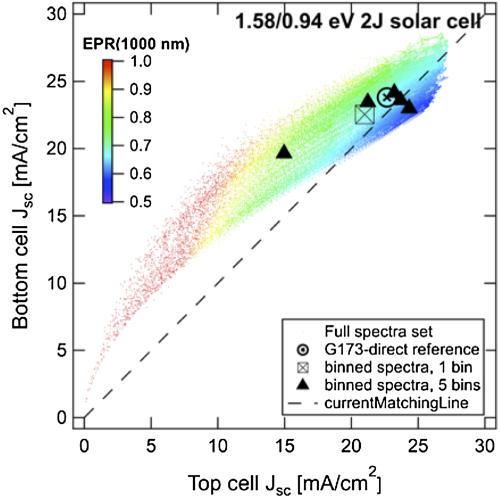当前位置:
X-MOL 学术
›
Prog. Photovoltaics
›
论文详情
Our official English website, www.x-mol.net, welcomes your feedback! (Note: you will need to create a separate account there.)
Spectral binning for energy production calculations and multijunction solar cell design
Progress in Photovoltaics ( IF 6.7 ) Pub Date : 2017-09-14 , DOI: 10.1002/pip.2943 Iván Garcia 1, 2 , William E. McMahon 1 , Aron Habte 1 , John F. Geisz 1 , Myles A. Steiner 1 , Manajit Sengupta 1 , Daniel J. Friedman 1
Progress in Photovoltaics ( IF 6.7 ) Pub Date : 2017-09-14 , DOI: 10.1002/pip.2943 Iván Garcia 1, 2 , William E. McMahon 1 , Aron Habte 1 , John F. Geisz 1 , Myles A. Steiner 1 , Manajit Sengupta 1 , Daniel J. Friedman 1
Affiliation

|
Currently, most solar cells are designed for and evaluated under standard spectra intended to represent typical spectral conditions. However, no single spectrum can capture the spectral variability needed for annual energy production (AEP) calculations, and this shortcoming becomes more significant for series‐connected multijunction cells as the number of junctions increases. For this reason, AEP calculations are often performed on very detailed yearlong sets of data, but these pose 2 inherent challenges: (1) These data sets comprise thousands of data points, which appear as a scattered cloud of data when plotted against typical parameters and are hence cumbersome to classify and compare, and (2) large sets of spectra bring with them a corresponding increase in computation or measurement time. Here, we show how a large spectral set can be reduced to just a few “proxy” spectra, which still retain the spectral variability information needed for AEP design and evaluation. The basic “spectral binning” methods should be extensible to a variety of multijunction device architectures. In this study, as a demonstration, the AEP of a 4‐junction device is computed for both a full set of spectra and a reduced proxy set, and the results show excellent agreement for as few as 3 proxy spectra. This enables much faster (and thereby more detailed) calculations and indoor measurements and provides a manageable way to parameterize a spectral set, essentially creating a “spectral fingerprint,” which should facilitate the understanding and comparison of different sites.
中文翻译:

用于能源生产计算和多结太阳能电池设计的光谱分箱
当前,大多数太阳能电池是为代表典型光谱条件的标准光谱而设计和评估的。但是,没有一个光谱可以捕获光谱变异性计算每年的能源生产(AEP)所需的电量,并且随着结点数量的增加,对于串联多结电池而言,这一缺点变得更加明显。因此,AEP计算通常是针对非常详细的长达一年的数据集进行的,但是这带来了两个固有的挑战:(1)这些数据集包含数千个数据点,当针对典型参数进行绘制时,这些数据点显示为分散的数据云;因此,它们难以分类和比较,并且(2)大量光谱带来了计算或测量时间的相应增加。在这里,我们展示了如何将大型光谱集减少为仅几个“代理”光谱,而这些光谱仍保留了AEP设计和评估所需的光谱变异性信息。基本的“光谱合并”方法应可扩展到多种多结点设备架构。在本研究中,作为演示,针对完整的光谱集和简化的代理集计算了4结器件的AEP,结果表明,对于少至3个代理光谱,它们都具有出色的一致性。这样可以进行更快(因而更详细)的计算和室内测量,并提供了一种可管理的方式来对光谱集进行参数化,本质上创建了“光谱指纹”,这应该有助于理解和比较不同的位置。
更新日期:2017-09-14
中文翻译:

用于能源生产计算和多结太阳能电池设计的光谱分箱
当前,大多数太阳能电池是为代表典型光谱条件的标准光谱而设计和评估的。但是,没有一个光谱可以捕获光谱变异性计算每年的能源生产(AEP)所需的电量,并且随着结点数量的增加,对于串联多结电池而言,这一缺点变得更加明显。因此,AEP计算通常是针对非常详细的长达一年的数据集进行的,但是这带来了两个固有的挑战:(1)这些数据集包含数千个数据点,当针对典型参数进行绘制时,这些数据点显示为分散的数据云;因此,它们难以分类和比较,并且(2)大量光谱带来了计算或测量时间的相应增加。在这里,我们展示了如何将大型光谱集减少为仅几个“代理”光谱,而这些光谱仍保留了AEP设计和评估所需的光谱变异性信息。基本的“光谱合并”方法应可扩展到多种多结点设备架构。在本研究中,作为演示,针对完整的光谱集和简化的代理集计算了4结器件的AEP,结果表明,对于少至3个代理光谱,它们都具有出色的一致性。这样可以进行更快(因而更详细)的计算和室内测量,并提供了一种可管理的方式来对光谱集进行参数化,本质上创建了“光谱指纹”,这应该有助于理解和比较不同的位置。


























 京公网安备 11010802027423号
京公网安备 11010802027423号